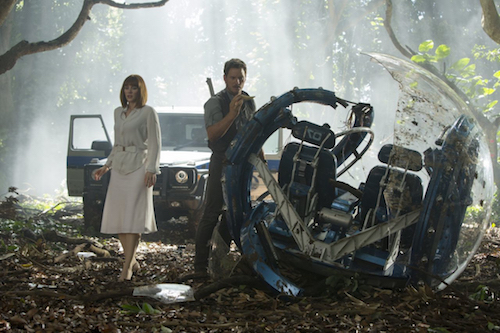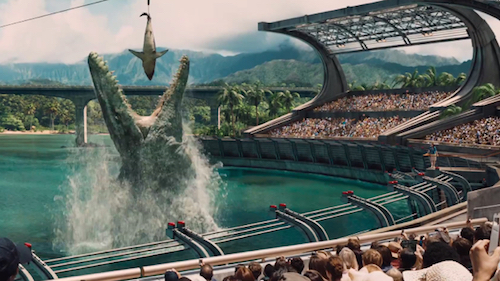Synopsis: Twenty-two years after the events of Jurassic Park, Isla Nublar now features a fully functioning dinosaur theme park, Jurassic World, as originally envisioned by John Hammond. After 10 years of operation and visitor rates declining, in order to fulfill a corporate mandate, a new attraction is created to re-spark visitor’s interest, which backfires horribly.
Release Date: June 12, 2015 MPAA Rating: PG-13
Genre(s): Action, Adventure
Film Review

Production
Even though The Lost World: Jurassic Park and Jurassic Park III were both critical disappointments, audiences still can’t get enough of Steven Spielberg’s Jurassic Park franchise. It’s been fourteen years since the last installment, and the wait is finally over; Jurassic World is here.
Jurassic World takes place twenty years after the events of Jurassic Park, with the Jurassic World attraction fully operational and open to the public. In order to boost attendance, the scientists in the genetic lab create a new species of dinosaur, a mashup of different species called an Indominus Rex. Of course, the I-Rex escapes from its heavily secured paddock on the same day that Jurassic World executive head Claire Dearing (Bryce Dallas Howard from The Help) has her nephews, Gray and Zach Mitchell (Ty Simpkins from the Insidious movies and Nick Robinson from “Melissa & Joey”), visiting her at the park. As the Jurassic World security struggles to contain the wild and unruly beast, Claire knows that the only person who can save the day is a Velociraptor trainer named Owen Grady (Guardians of the Galaxy‘s Chris Pratt). As Claire and Owen do everything they can to stop the I-Rex, they are forced to make a difficult decision – should they risk further casualties by using the Raptors to bring down the I-Rex?

It would seem that the proprietors of Jurassic World have learned nothing from the disaster that occurred in Jurassic Park. The screenplay for Jurassic World, written by Rick Jaffa and Amanda Silver (both of whom wrote Rise of the Planet of the Apes) along with Derek Connolly (Safety Not Guaranteed), follows the same pattern of the first film, with a search for missing kids going on amidst the chaos of a dinosaur rebellion. That’s not necessarily a bad thing; the original Jurassic Park is easily the best movie in the franchise, and if it’s not broken, why fix it?
The chief fault in Jurassic World lies within its stale characters. In Spielberg’s original, the viewer felt emotionally invested in the scientists and children, so much so that what was happening to them actually mattered. Jurassic World director Colin Trevorrow (Safety Not Guaranteed) fails to make that connection with the audience, so every character just becomes potential dinosaur food in the eyes of the viewer. There are thin attempts to generate empathy through exposition and dialogue – the kids’ parents’ impending divorce, Owen and Claire’s failed first date – but none of it is successful at humanizing the characters. The Amblin logo is shown at the beginning of Jurassic World, but that’s about all of the heart that the film has.
As it progresses and more dinosaurs get involved, Jurassic World gets more and more ridiculous, but it’s actually kind of awesome that way; Dr. Malcolm’s Chaos Theory from the first film comes to bright and bloody life as the park falls under attack, and it’s thrilling to watch. The ending of the film is a bit of a cop-out, but only because it’s not set up – it could have been remedied by adding a single, short little scene, making the conclusion a call-back instead of a deus ex machina. But Jurassic World doesn’t do that, so it ends on a head-scratcher.
Okay, this is starting to sound like a negative review, but it’s really not. Jurassic World is an incredibly fun movie to watch. It lacks the genuine character empathy of the original film, but as for dinosaur-eating-people fun, it’s a hit.

Special Effects
A Jurassic Park sequel is only as good as its visual effects and, of course, the effects in Jurassic World look great. Most of the big dinosaur scenes are done with CGI, but that’s to be expected in the age of digital movie production. In some places, where close-ups are needed or where human cast members interact with the dinosaurs, animatronics or puppets are used. There’s nothing groundbreaking within the visuals, just a lot of slick and well-done dinosaur creature creation. There are some new dinos, most notably the aquatic Mosasaur from the trailer and a bunch of new flying Pterodactyl-like guys, and of course the Indominus Rex, and all are fun additions to the mythology. The visuals in Jurassic World are just as stylish as one would expect from a Spielberg-produced Jurassic Park movie.


Action Sequences
Jurassic World is carried by its action sequences. What the film lacks in the way of character development and empathy is more than made up for in kick-ass dinosaur fighting. It doesn’t matter if the Indominus Rex is fighting the people or the other dinosaurs, its battles are extremely entertaining. A high point is a scene where the I-Rex takes on an Ankylosaurus, more commonly known as one of those turtle-like dinosaurs with a club for a tail. Of course, the I-Rex wins, but the Ankylosaurus puts up an impressive fight for an herbivore, and the scene even ends with a tribute of sorts to the T-Rex/Jeep scene from the first Jurassic Park. The best reason to see Jurassic World is the action, because by the time the movie hits its stride, it’s a non-stop thrill ride.
Cast and Crew
- Director(s): Colin Trevorrow
- Producer(s): Frank MarshallPatrick Crowley
- Screenwriter(s): Rick JaffaAmanda SilverDerek Connolly
- Story: Michael Crichton
- Cast: Chris PrattBryce Dallas HowardIrrfan Khan Vincent D’OnofrioTy SimpkinsNick RobinsonJake JohnsonOmar SyBD WongJudy GreerLauren LapkusKatie McGrath
- Editor(s): Kevin Stitt
- Cinematographer: John Schwartzman
- Production Designer(s):
- Costume Designer: April Ferry
- Casting Director(s): John Papsidera
- Music Score: Michael Giacchino
- Music Performed By:
- Country Of Origin: USA
